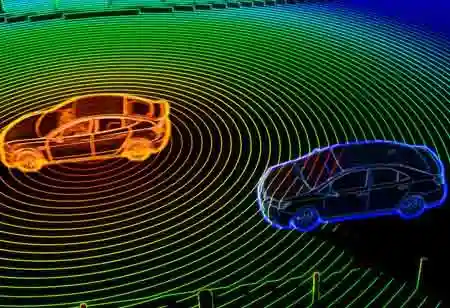THANK YOU FOR SUBSCRIBING
THANK YOU FOR SUBSCRIBING
Be first to read the latest tech news, Industry Leader's Insights, and CIO interviews of medium and large enterprises exclusively from Auto Tech Outlook

By
Auto Tech Outlook | Monday, October 23, 2023
Stay ahead of the industry with exclusive feature stories on the top companies, expert insights and the latest news delivered straight to your inbox. Subscribe today.
Autonomous vehicles use a system of sensors and an onboard computer to map the surrounding environment and then use that information to steer through ever-changing situations that include other vehicles, pedestrians, traffic signals, weather conditions and hazards in the roadway.
Automotive design, production, and operation all depend on sensors. Robotic arms, for instance, are used during production to finish the design and paint automobiles. The sensors are used to count the number of claddings and other components in the internal structures, as well as to measure the thickness of the paint being sprayed on the instruments. While operating, sensors track pollution and fuel usage in engines, enabling more effective fuel use.
The semi-autonomous capabilities seen on certain contemporary automobiles, like automated parallel parking, are similarly powered by sensors. These sensors will be even more important when cars incorporate more autonomous features. Autonomous vehicles map their environment using a set of sensors and an onboard computer. They then use this information to navigate through a variety of dynamic scenarios, such as other vehicles, pedestrians, traffic signals, changing weather, and road hazards.
While each of the sensors draws only a small amount of electricity from the vehicle's battery, over time, with more sensors, all that power adds up. Electricity is now used to power automobiles themselves as well as their electrical components due to the popularity of electric vehicles. Any electricity that an electric automobile consumes for its sensors cannot be used to directly power the car.
Automobile sensors come in two varieties: active and passive. Active sensors emit waves of energy and then search for things based on the information they receive back. RADAR is one instance where radio waves are emitted and returned by reflective objects in the beam's path. In the same way as cameras, passive sensors simply take in data from their surroundings without generating any waves themselves.
In the case of autonomous vehicles, perception-based sensing is frequently employed to navigate the vehicle. Particularly, a field of view is produced by technologies like radar and LiDAR using a medium like radio waves or light waves. Raw data is extracted from reflections and then examined.
Many of these sensing techniques exhibit large false positives and negatives, which could lead to a dangerous result in challenging circumstances. The majority of sensing technologies operate in this abstract manner of observation; virtually all sensors function by watching their environment. The raw data from the majority of sensors must be sent to a host CPU for analysis. As the raw data will generally be quantised and encoded before being transferred, this adds another degree of abstraction.
For tire-pressure measurement systems (TPMS), it is possible to anticipate frequent data transmission from the sensor. Since the TPMS is attached to the tire's valve, the complete assembly must be compact and this includes the battery. Hence, it might need to be changed after a short time. This results in lost revenue for vehicles with high rates of usage, such as taxis or delivery trucks, since the time spent out of service. These cars will operate practically continually until they are fully autonomous, making any downtime costly.
Nowadays, the majority of sensors produce digitised data or data that is meant to be digitised to be processed. Regarding the bandwidth needed to transmit the data or the amount of memory needed to store it, this quantisation is practical. It also eliminates a significant portion of the data that is deemed unnecessary. This could be a result of the system searching for peaks or excursions outside of predetermined bounds.
This is due in part to the fact that the sensor data powers the hub's electronics, making every component useful. This steady analogue signal carrying a ton of important information is a stream of unprocessed data. It's critical to process it in a way that produces this value. Anything from a basic microcontroller to a multicore CPU capable of intense parallel processing can be used to accomplish it.
To achieve edge inferencing, developers are porting AI technology to low-power MCUs. This explains how to embed an inferencing model that was created using AI training technologies based on enormous volumes of data. The model is then simplified and tuned to run on an embedded MCU that is significantly smaller and easier to use. Using this method, a convolutional neural network (CNN) of any complexity can be run on an ultra-low-power MCU in an application powered by EH-Modules.
Since the beginning of time, engineers have been drawn to the concept of free energy. Energy-free data is a significantly more recent idea. Although energy-harvesting technologies help to some extent maximise the conservation of energy rule, its full potential has not yet been unlocked. A crucial step in that direction is to streamline the power and data interface.
The use and performance of several integrated sensors can directly impact the safety and viability of automated driving vehicles. Sensors are essential to an automated driving system's ability to perceive the environment around the vehicle. Before sensor fusion and obstacle detection procedures can be used, sensor calibration, the fundamental building element of any autonomous system and the sensors that make up its component sensors, must be appropriately carried out.
 Copyright © 2025 AutoTech Outlook. All Rights Reserved | Privacy Policy | Subscribe | Sitemap | About us | Feedback Policy | Editorial Policy
Copyright © 2025 AutoTech Outlook. All Rights Reserved | Privacy Policy | Subscribe | Sitemap | About us | Feedback Policy | Editorial Policy 



